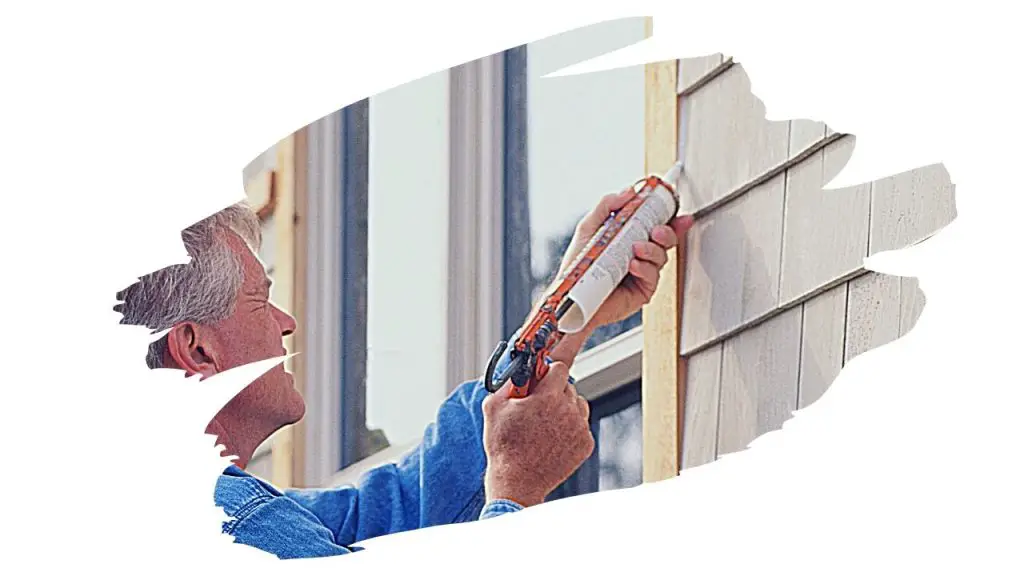If you love the look of wholesome natural home design, then cedar siding boards can make your property look incredible.
But even a dream house – one that has been built to perfection – will need a touch up every now and then.
And when it comes to cedar siding, ongoing maintenance is key to keeping that Western Red Cedar looking great for years.
Now, if your cedar siding has been installed properly, then generally, caulking joints and siding should rarely be an issue.
So, why would you even think about caulking cedar siding?
Generally, you don’t need to caulk cedar siding that has been installed within the last 10-15 years. However, sometimes poor workmanship on a building could result in you having to caulk siding and joints. And other times, old cedar siding will simply need a bit of upkeep.
In which case, caulking is a quick and easy way to create a water-tight seal along hairline cracks and seams between cedar boards.
So, now you know why we sometimes need to apply caulk. But, keep reading to discover everything you need to know before you go and grab that caulking tool…

This post may contain affiliate links to products that we receive a commission for (at no additional cost to you). Learn more here.
Why Should You Even Bother Caulk Cedar Siding?
Well, the reason we apply caulking in the first place is to try and prevent water from seeping in along the seams between two boards.
However, if a brand new building has had its cedar siding properly installed in the first place, then it should not need any caulking work.
This is because you should try and caulk around doors and windows – sealing them tightly – before you install that cedar siding.
Still, cedar is an eco-friendly home building material used not only for siding, but also for roofing and cladding.
Related Post: Should You Use Teak Oil On Cedar Wood? (Best Practice Revealed)
In other words, that cedar siding is going to be regularly exposed to rain, humidity, and damp. Which means, that over time, you will probably need to caulk specific problem areas anyway.
That is, at least, if you want to prevent water from leaking through.
So, to sum up, you don’t need to caulk new siding, but you may need to spot-caulk problem areas later on.
It is also worth pointing out that even spot-caulking cedar is not a one-and-done problem solver.
Areas around the home, that have a lot of regular moisture buildup, shouldn’t be caulked. Especially when there is a likelihood that the caulking will only end up trapping water into the siding.
For example, caulking under windows – which is an area where water can regularly build up due to condensation from the glass – is a bad idea.
Is Cedar Siding High Maintenance?
The thing that makes cedar so eco-friendly, (as an all-natural construction material), unfortunately also makes it expensive to upkeep.
There is no getting around it. As beautiful as it may be to look at, cedar siding needs a lot of on-going maintenance. And here’s why;
- It is more prone to moisture damage (which means it is more prone to rot).
- It will need a new stain or paint job every 3 or so years.
- It will attract insects and bug damage.
- It might even attract a nesting woodpecker or two!
How Many Years Does Cedar Siding Last? You are going to need to replace cedar siding planks within 10 to 15 years of them being installed. At most, they might be able to hold out for 20 to 30 years, if they are very well-kept.
What Is The Best Caulk Material For Cedar Siding?
If your cedar siding needs to be caulked, then you should use an acrylic-latex, polyurethane or acrylic-silicone caulking product.
It is also worth stressing, that you should absolutely avoid using any caulking product that is made from 100% silicone.
Cedar, (especially Wester Red Cedar, which is what cedar siding is usually made out of), simply doesn’t play well with 100% silicone material.
Don’t get me wrong, sure, you could try using 100% silicone caulking on your cedar siding. However, within a year or two it will end up sliding right off the siding – leaving behind a messy, leaky slime in its place.
Not only that, what little slime that 100% silicone caulk does leave behind will make it difficult for you to re-caulk over it.
Do You Have To Remove Old Caulking Before Applying New Caulk? Yes, no matter what kind of old caulking product you used, you need to scrape it all off first. Otherwise, the new caulk can’t make a water-repellent seal.
What Is The Best Caulk For Exterior Siding?
You won’t go too far wrong by going with an affordable, yet dependable, caulking that can offer a little bit of give.
Even superbly installed cedar wood siding is going to expand and contract – even if only minimally – with seasonal changes in humidity. So you need to use a caulking product that won’t crack under all of that movement.
You also want to use a caulk that has an anti-mildew ingredient added to it – which is very important if you want to prevent mildew fungi from setting in due to damp.
This is why you should go for DAP INC’s Acrylic Latex Caulk. It is both moisture and mildew resistant, is super simple to apply, and cleans off easily too.
Check out the latest prices for this Acrylic-Latex caulk over on Amazon.
5 Quick Tips For Caulking Cedar Siding
As a general rule of thumb, applying caulking is not a very complicated process. But, there are a few things you need to keep in mind if you want that caulk to look great for years to come;
Tip 1: Avoid Caulking Around Windows And Doors
I mentioned earlier in this article that due to condensation on windows, you’ll want to avoid caulking around window sills. However, there is another reason why you’ll typically want to avoid caulking these areas.
Wood needs to ‘breathe’ – which is an abstract way of explaining the fact that wood moves.
In extreme cases, when wood gets wet or damp gets trapped in it, it will move so much it will warp.
And even well-sealed wood, or planks that have a low moisture content (MC), will move about a little bit.
Now, caulking may prevent water from getting in between those cracks. However, it also doesn’t make it easy for wood to move around and take a breather.
What Is Moisture Content (MC)? Moisture content measures the amount of water found in wood. Freshly cut green wood has a moisture content of 100%. Whilst KDAT (Kiln Dried After Treatment) lumber will typically have a moisture content level of 19% or less.
Tip 2: Push That Caulk (Don’t Pull It)
When you apply caulk, you want it to lay on as evenly as possible.
In which case, in order to get an even bead, hold your caulking tool at a roughly 45-degree angle to the seam you want to seal.
And then slowly apply the caulk by pulling the point of the caulking tool along the joint.
Tip 3: Get Rid Of Any Dust Before You Start Work
Try to always apply caulk directly onto the cedar. So remove any dust or dirt first before you get started.
Tip 4: Let It Dry Before You Apply
Putting caulk onto a damp or wet surface is a fools-errand. The caulk simply won’t stay on (let alone form a water tight seal).
Clean the cedar siding and wait for it to dry before you start.
Tip 5: Don’t Fill In The Crack, Layer Over It
It can be tempting to just overdo it with caulk and stuff as much of it into the exposed seam as possible.
However, as caulking starts to dry it will reduce in size and shrink. So if you overfill the seam it’ll look needlessly messy.
So, you will be better off if you simply layer the caulk over the crack instead. And before the first layer begins to dry, smooth it over and add a second layer of caulk neatly over it.
This will leave behind a tidier looking caulked finish once it dries.
Final Thoughts
If your cedar siding needs a lot of caulking work, then caulk will just be a sticky plaster solution.
Applying caulking onto cedar siding can handle water leakages over the short term. However, over time, it may cause more problems than it solves. So don’t use caulking as a long term solution for persistent water-seepage issues.
However, if you really need to seal those gaps, then stick to using acrylic-latex, polyurethane or acrylic-silicone caulks. And steer clear of 100% silicone caulking (because they won’t stay on the cedar).


